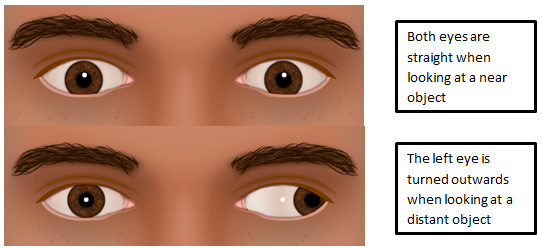- Reference Number: HEY1150/2020
- Departments: Ophthalmology Department, Orthoptic
- Last Updated: 19 December 2023
Introduction
This leaflet has been produced to give you general information. Most of your questions should be answered by this leaflet. It is not intended to replace the discussion between you and the healthcare team, but may act as a starting point for discussion. If after reading it you have any concerns or require further explanation, please discuss this with a member of the healthcare team.
What is Intermittent Distance Exotropia?
A number of different types of subcategory of squints exist. Intermittent distance exotropia is a specific type of squint (strabismus). With this type of squint when an individual looks beyond 3 meters, one eye turns outwards towards the ear. The squint may be constant or intermittent on distance viewing. You may find it is more noticeable when your child is tired, unwell or daydreaming. When the eye turns out some children occasionally close their eye, particularly in bright sunlight. Most children are able to keep their eyes straight and working together when they carry out near tasks such as reading.

What is the cause of Intermittent Distance Exotropia?
Intermittent distance exotropia is the result of an imbalance of the eye muscles. Everyone has a level of control over their eyes, however if the imbalance is too great it can become too difficult to keep the eyes under control, particularly in the distance. Occasionally there can be family history of this type of squint but this is limited to immediate family.
Can this impact vision and why do I need to attend appointments?
Children are not born with fully developed vision; in the same way they learn to speak they have to learn to see. Children with intermittent distance exotropia usually are not at risk of amblyopia (lazy eye), as there are times when both eyes receive appropriate visual stimulus. You may notice your child rubbing or closing one eye (usually the eye that squints), particularly in bright sunlight. It is rare for young children to notice symptoms such as double vision with this condition.
If your child is thought to have intermittent distance exotropia, their focussing will be checked and glasses will be prescribed, if required. Your child will be advised to wear the glasses for all waking hours. Regardless of whether glasses have been prescribed or not you will be invited for a follow-up appointment. At this appointment the future management of your child’s condition will be discussed in more detail.
Generally the options to manage this type of squint fall into the following categories:
- No formal treatment but continue monitoring the squint
- The use of spectacles
- Orthoptic exercises in combination with spectacles
- Squint surgery
All treatment options are there to encourage and maintain your child’s vision and depth perception (3D vision). Your appointments with the Orthoptic Team will guide the management plan for your child, which may change dependent on your child’s control of their squint. Not all options work for all children.
Are there any complications or risks?
Generally this type of squint poses a relatively low risk to your child’s visual development due to its intermittent nature. Some children however may develop amblyopia (lazy eye) and as a result require treatment (amblyopia therapy). There is a risk that the squint may deteriorate over time and become constant; regular visits with the Orthoptic Team will monitor this.
The treatments available allow a range of options to be considered. All treatment options have their advantages and disadvantages and these will be discussed with you at your child’s appointment.
Should you require further advice on the issues contained in this leaflet, please do not hesitate to contact the Orthoptic Department on telephone (01482) 816605.

